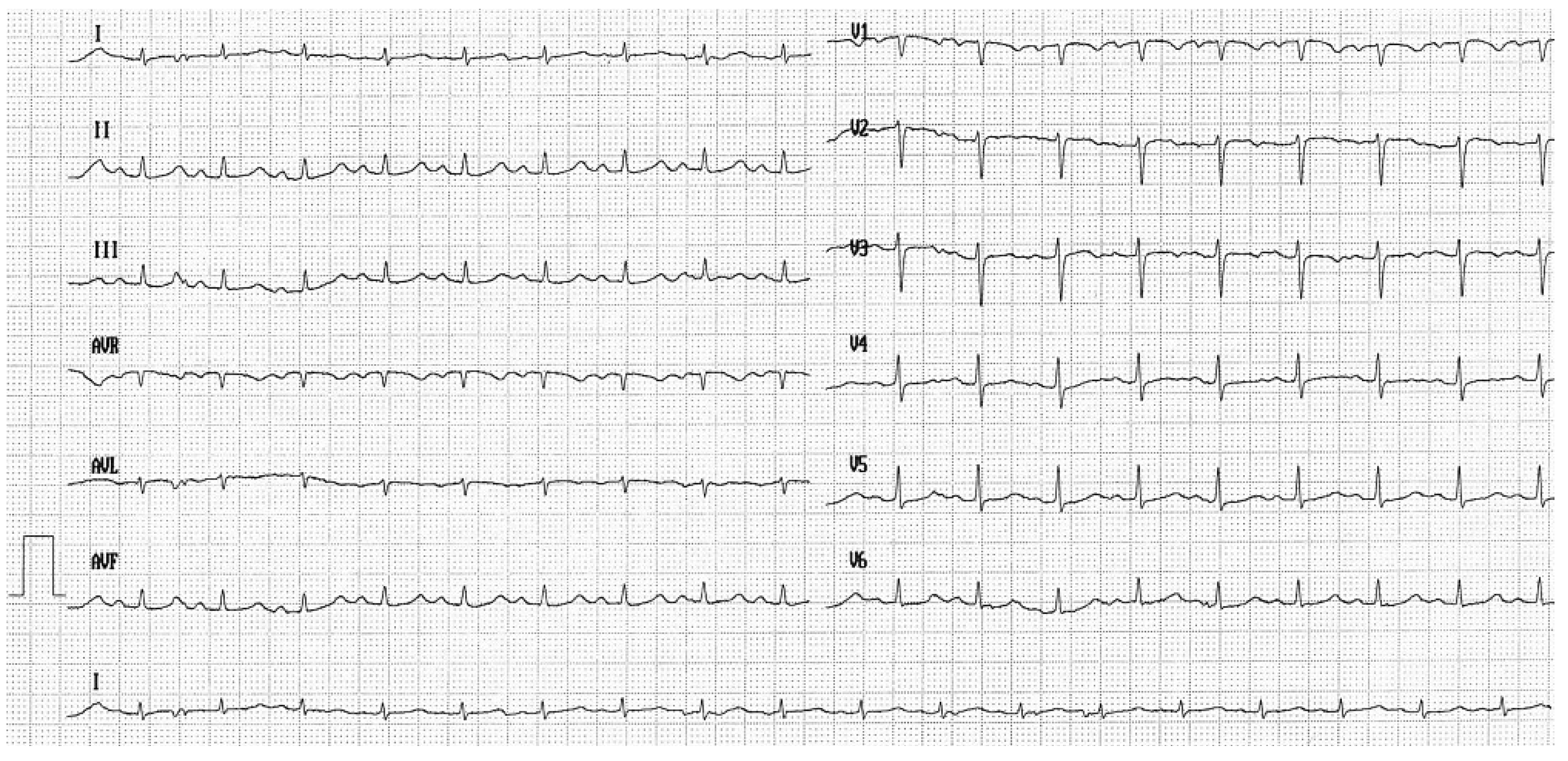Osborn Waves Due to Severe Hypothermia
Case description
Discussion
- -
- shivering artefacts
- -
- sinus bradycardia
- -
- PR / QRS / QT prolongation
- -
- J waves (Osborn waves)
- -
- atrial arrhythmias (common when the temperature falls to below 32 °C)
- -
- ventricular fibrillation and asystole (especially if the temperature is <28 °C)
Conflicts of Interest
References
- Solomon, A.; et al. The electrocardiographic features of hypothermia. J Emerg Med. 1989, 7, 169–173. [Google Scholar] [CrossRef] [PubMed]
- Osborn, J.J. Experimental hypothermia; respiratory and blood pH changes in relation to cardiac function. Am J Physiol. 1953, 175, 389–398. [Google Scholar] [CrossRef] [PubMed]
- Gussak, I.; et al. ECG phenomenon called the J wave. History, pathophysiology, and clinical significance. J Electrocardiol. 1995, 28, 49–58. [Google Scholar] [CrossRef] [PubMed]
- Okada, M.; et al. The J wave in accidental hypothermia. J Electrocardiol. 1983, 16, 23–28. [Google Scholar] [CrossRef]
- Yan, G.X.; Antzelevitch, C. Cellular basis for the electrocardiographic J wave. Circulation. 1996, 93, 372–379. [Google Scholar] [CrossRef] [PubMed]
- Vassallo, S.U.; et al. Aprospective evaluation of the electrocardiographic manifestations of hypothermia. Acad Emerg Med. 1999, 6, 1121–1126. [Google Scholar] [CrossRef] [PubMed]
- Sridharan, M.R.; Horan, L.G. Electrocardiographic J wave of hypercalcemia. Am J Cardiol. 1984, 54, 672–673. [Google Scholar] [CrossRef] [PubMed]
- De Sweit, J. Changes simulating hypothermia in the electrocardiogram in subarachnoid hemorrhage. J Electrocardiol. 1972, 5, 93–95. [Google Scholar] [CrossRef] [PubMed]
- Yan, G.X.; Antzelevitch, C. Cellular basis for the Brugada syndrome and other mechanisms of arrhythmogenesis associated with ST-segment elevation. Circulation. 1999, 100, 1660–1666. [Google Scholar] [CrossRef] [PubMed]
- Patel, A.; et al. The Osborn wave of hypothermia in normothermic patients. Clin Cardiol. 1994, 17, 273–276. [Google Scholar] [CrossRef] [PubMed]



© 2009 by the author. Attribution - Non-Commercial - NoDerivatives 4.0.
Share and Cite
Park, C.-I.; Burri, H. Osborn Waves Due to Severe Hypothermia. Cardiovasc. Med. 2009, 12, 17. https://doi.org/10.4414/cvm.2009.01385
Park C-I, Burri H. Osborn Waves Due to Severe Hypothermia. Cardiovascular Medicine. 2009; 12(1):17. https://doi.org/10.4414/cvm.2009.01385
Chicago/Turabian StylePark, Chan-Il, and Haran Burri. 2009. "Osborn Waves Due to Severe Hypothermia" Cardiovascular Medicine 12, no. 1: 17. https://doi.org/10.4414/cvm.2009.01385
APA StylePark, C.-I., & Burri, H. (2009). Osborn Waves Due to Severe Hypothermia. Cardiovascular Medicine, 12(1), 17. https://doi.org/10.4414/cvm.2009.01385



